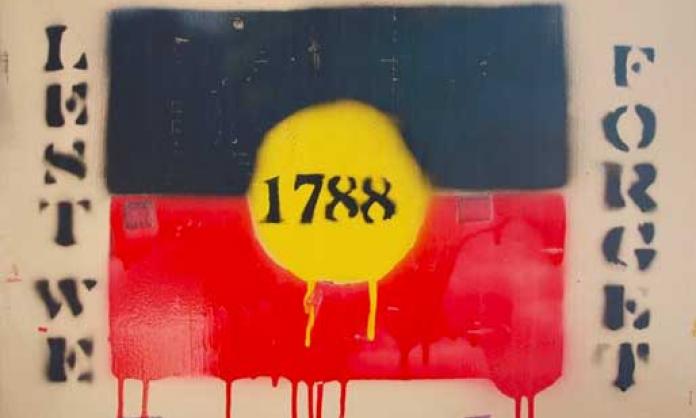Once again, as every year since 1808, the first recorded celebration of the beginning of colonisation, Indigenous people have to live through days of what Black activists in 1988 dubbed the “masturbation of a nation”, mocking the slogan “celebration of a nation”.
They’ll have to put up with the swaggering arrogance of a racist prime minister who in November contemptuously denied their history: “It’s hard to think that back in 1788 [Sydney] was nothing but bush.” This is the lie that, ever since the declaration of Terra Nullius in 1835, has served as the ideological justification for stealing the land from an ancient society with a complex culture capable of sustaining the continent for 60,000 years or more.
If there was only bush there was no genocide, no culture trashed, no sacred sites to trample. What about massacres or the Stolen Generations? To the political right, that’s just Black Armband History peddled by “whingeing Blacks” backed up by do-gooders.
While the Australian flag is draped everywhere, and the speeches sing the praises of this supposedly free, multicultural society, the Indigenous owners live day in and day out with the consequences of the racism rooted in the colonial project of occupation.
While the nation celebrates in 2015, the lives of Indigenous people are blighted by the NT Intervention begun in 2007 by the racist Howard government with Labor’s support.
To think that, on entering their lands, the title to it won by heroic struggles, they pass humiliating signs declaring “no alcohol” and “no pornography”. The truth is that, as a proportion of the population, there are more Indigenous people who are teetotallers than among non-Indigenous.
Talk of “freedom” is a mockery for Indigenous communities denied autonomy or dignity by the regime of “income management” or quarantined welfare payments. A cursed card determines where they can spend their meagre income or what they can buy; unable to travel for family business or, alternatively, forced to travel for miles because it’s only usable in designated shops.
While “the nation” pays homage to the arrival of the first invading fleet, remember that almost half of Aboriginal men and over a third of women die before they turn 45. Their children are denied their right to bilingual education. Their communities, if designated “remote”, are being defunded, forcing increasing numbers into squalid camps around the outskirts of towns.
Dollar signs flash as mining magnates like Hugh Morgan and Twiggy Forrest salivate over the resources below the earth which belongs to the traditional custodians.
The cruelty and horror spelled out in the Stolen Generations Report of 1998 is overwhelming. Genocidal programs forcibly ripped children from families for more than a century, often sending them to abusive church institutions or middle class families who sexually abused them while using them as unpaid labour.
But in spite of the apology and “reconciliation”, it did not end. Today, removal of Aboriginal children – including babies taken at birth from their mothers – is even more widespread. More than a third of all children removed from their families are Aboriginal – when they are only three percent the population.
In 2013, the left wing journalist John Pilger told of meeting “a group of Aboriginal grandmothers, all survivors of the first Stolen Generation, all now with stolen grandchildren. ‘We live in a state of fear, again’, they said.”
Indigenous people live with criminally inadequate health, education and housing, but the criminal injustice system always has resources to police and harass them. In 2012, a whistleblower (later sacked) revealed that almost $80 million was spent by the Northern Territory government on the surveillance and removal of Aboriginal children. At the same time only $500,000 was spent on support services for the same impoverished families. She said: “If South Africa was doing this, there’d be an international outcry.”
Twenty-four years ago the Royal Commission into Black Deaths in Custody made 339 recommendations. Some of the most important directives were for police to stop arresting and jailing Indigenous people for petty crimes such as drunkenness, swearing or unpaid fines.
But law and order campaigns, racist hysteria about Aboriginal alcoholism and mandatory sentencing have created a perfect storm which has sent Indigenous incarceration soaring from 14 percent of the adult prison population in 1991 to 26 percent today. In WA they’re 20 times more likely to be jailed than non-Indigenous. The cycle of discrimination and despair meant that within three months last year in WA, a man jailed for failing to obey an order to “move on” by police and a woman jailed for unpaid fines died in their cells.
And predictably, 18 months into a Territory mandatory alcohol rehabilitation program, which experts warned would have tragic results, Indigenous people were on the streets protesting at the death of an Aboriginal woman in the treatment centre in Alice Springs. Magnifying their racist injustice, the government withheld news of her death for over a month. Legally, even though she was denied her freedom, her death does not count as a death in custody.
A cartoon published for the 1988 anti-bicentenary protests sums up the relationship of the traditional owners of this land with the state based on their dispossession, and its cultural and social policies of genocide. One person asks “Did ya know Darby died?” “Died!!! I didn’t even know he’d been arrested!!”
Invasion Day. Nothing for Indigenous people to celebrate. Nothing for any decent human being to celebrate.









